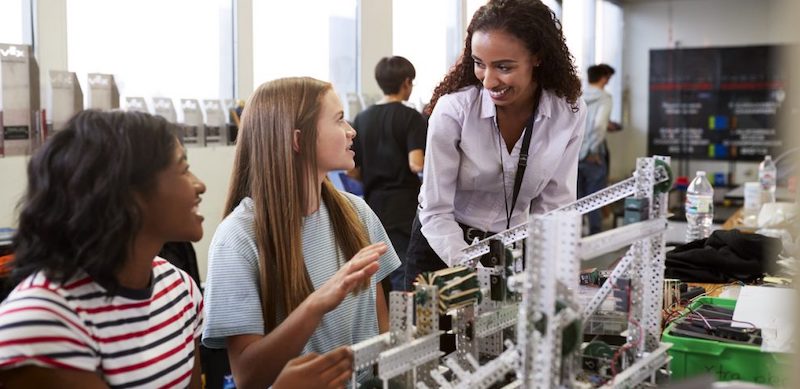Despite its prominence across the real world and connections with many careers, not every student tries to pursue STEM. More importantly, so many students lose almost all interest in STEM before they even get to middle school. In a lot of cases, educators need to have reached their students while they’re in elementary school (between second and fifth grade) to help them to develop and maintain a strong enough interest in STEM. One possible way to do that is by exposing them to STEM experiments and learning challenges on a regular basis, which could help kids develop an early and sincere interest in and passion for STEM. So, this week, let's discuss some ways of doing just that.
Building Passion Through Project-Based Learning
STEM-focused classes are often hands-on and project-based. As such, the terms ‘STEM education’ and ‘project-based learning’ often walk hand in hand. While we wouldn’t necessarily advocate for using them interchangeably, there are, however, a good amount of similarities between them. One reason PBL helps students discover passions, which could very well include something STEM-related, is in its authenticity. In PBL, students might spend weeks or maybe even months working on a particular project and towards their desired outcome, often developing an authentic attachment to that work in the process. And, lots of times, they’re attempting to solve a real problem. PBL also provides opportunities for choice—in types of projects, technology students use, and the content areas they cover. So, this is how a lot of children may initially find new passions to explore over time.
Examples of connecting STEM and PBL.
PBL often helps kids develop all sorts of skills as they pursue something they genuinely care about. These include various tech skills, digital citizenship skills, or even key soft skills as they contribute to improving their community. When working on something they are truly passionate about, children tend to fully engage with it, often developing original questions or challenges to address individually or collaboratively. This kind of passion can really drive engagement and execution, and students can also transfer it to the real world. A lot of the time, experiences with using educational technology might even help to cultivate new passions. Kids love trying new things, so adding new angles to traditional tasks can, as we know, boost engagement. It could even lead to new passions and new levels of authenticity in learning.
Benefits of STEAM vs. PBL.
One key benefit of project-based learning is that students can typically choose the main focus areas of the projects. This, of course, allows them to pursue something they have a genuine interest in improving. It can be something that has affected them personally or something they’ve seen affect somebody close to them. Since the learning is active, students can lead their own PBL experiments, organize their own results, and interpret their discoveries in the way that works best for them. At the same time, they still have chances for reflection, which is important for finding what they are passionate about. It seems simple but, by genuinely caring about their projects, kids can develop new or deeper passions for something they could potentially make a career of—with so many opportunities waiting in STEM.
Sparking a Passion for STEM
There are a lot of different ways of exciting students about the prospects of a STEM education. Technology definitely is one of those options but there are certain strategies teachers can use when it comes to zeroing in on various types of technology to invest in. One of those technology types is virtual reality (or VR). Before you freak out, VR isn’t some overly expensive gimmick. It can actually be affordable in most cases and it is proven to boost student engagement, retention, and achievement. Plus, there is now quite a wide range of VR equipment, which makes it easier on teachers to find resources that fall into their specific instructional, classroom, and budget needs. It can be tough to motivate children today and sometimes tougher to excite them but VR provides an intrigue and outlet to help them build STEM passions with up-close experiences.
Using technology to mirror STEM-related experiences.
One thing that teachers struggle with is helping students to see connections between abstract educational concepts and their real-world applications. This often leads to a lack of motivation in the classroom or kids wondering why they're even learning certain things. Many education professionals argue that the hands-on experiences are key in combatting this mindset and we'd tend to agree. There are so many new challenges facing our world and, in a lot of cases, children who are currently in school will be searching for the creative solutions later on. Understanding how massive issues like climate change, for example, affect the planet or our lives may spark a passion for reversing it they didn’t know they had. And, as for VR systems? Children can see the effects of this particular problem (and others) without even leaving the classroom.
How new-age tools help students discover new passions.
VR is one of the latest instructional areas for helping students explore some new worlds and discover new interests. They could see what works well in certain situations and even identify potential improvements in other places or at home. It can also perhaps inspire them to pursue changes they might have never known were needed through simple enlightenment. Because these technologies have come a long way, educators can suggest using VR to explore STEM-related opportunities and illuminate passions. Working together, VR and STEAM-based hardware tools can help kids change their outlooks on potential careers and, ultimately, their futures. While it seems simple in theory, getting VR into the classroom can be challenging but, once implemented, it can open up new ideas and ignite a spark for pursuing real-world STEM opportunities.

How Students Can Discover a Passion for STEM
In an ideal world, students could consistently take part in STEM learning that connects school, community, and industry. While it would certainly be tough for educators to offer this all the time, however, it is possible at times. This type of learning often helps students to realize that they do have a passion for STEAM or that they can build on to passions they already know they have. Not only is it important for students to discover STEM passions if they have them, however, it's important for teachers to create the opportunity for them to do so. Students also benefit from teachers who share similar passions and look to create the best learning experiences possible. It’s not always easy, however, since their responsibilities are constantly evolving but knowing that a solid STEM education can tremendously benefit students is important to remember.
Designing STEM lessons to unlock student creativity.
Remember that, even if you don’t think you love teaching STEM education, you can easily learn to love it. Teachers often start out by designing STEM lessons that enable students to make real-world connections to the content. Developing projects in which children can serve others—either their peers or even complete strangers—is another idea. Also, seeing student passions come out as they take greater pride in projects is something that educators could make a top goal. STEM, however, is different than some of their other core subjects since the concepts students learn and the creativity they rely on can immediately help them solve real-world problems and develop passions. So, finding creative ways to highlight these connections helps educators—especially those new to STEM—multiply student passion quickly.
Service learning and the connection to PBL and STEM.
Service learning is another way for teachers to build up their own STEM passions. Like students, they may not know what they’re passionate about until discovering where these talents are needed most. Helping all children see that their STEM skills could help them out in some very practical situations could help remove some of the intimidation from teaching something new (like STEM) as well. Together, students and teachers can uncover the true relevance of STEAM and applying their passions often enhances how they learn. Plus, integrating STEAM concepts and tools throughout the curriculum is effective—rather than allocating limited time for STEM. The more teachers and students practice this, the more they'll grow and continue to do so.
How to Ignite a Passion for STEM in the Classroom
In a nutshell, the way students perceive STEM education could determine their success in the future. Some people brush it off and assume that, if kids work hard, they can succeed. Others, however, believe success is tied to staying competitive globally. STEAM careers, however, are among the fastest growing professions with computer science jobs making up a significant portion of them. But, not all students know this or even believe they’re talented enough to make an impact, leading to less of a drive to pursue these opportunities. This piece of it, fortunately, is something that educators might actually be able to control. If they could help kids develop STEM passions, then maybe they'd be more likely to commit.
Lifting student passions in all classes.
In reality, STEAM is more than a collection of theories and successes. It’s a way of thinking—an innovative approach to overcoming challenges—and it helps us see the world in new ways. As we’ve said, STEM can fit into any school subject, but teachers would still need a good way to ignite that passion in their students. Without passion, there's not a huge chance they'd try to make a career out of it. Especially when students find science, math, and other classes to be boring, difficult, or abstract, teachers can try to make all these experiences more hands-on, relatable, and enjoyable. Learning STEAM subjects should never be boring and adding hands-on experiences whenever possible allows students to see concepts in action—a great first step in increasing the appeal.
The right lessons and projects for students.
We don’t want to oversimplify, but one key for STEM engagement is making projects more appealing using hands-on elements. This presents so many different possibilities and options for students in different grade levels. In elementary school, for example, they can learn important coding skills simply by utilizing robotics tools on a regular basis. Elementary robotics tools aren't typically that complex and help kids apply those skills they learn to future problem solving. Then, once in middle or high school, they can build on what they know and explore more advanced computer science concepts, using this confidence to take their skill sets in another direction—maybe focusing on entrepreneurship, community improvement, or something else. All that matters is that their education offers them an opportunity to practice hands-on discovery.

Turning STEM Passion Into a Career
Part of the reason we preach the importance of STEM education is that some student somewhere is bound to change the world with an invention, a cure, or an innovation. This, unfortunately, won't happen for every student but the potential of discovering that one breakthrough could help propel more students to focus on STEAM, which is all we can ask. For today's students, it’s very inspiring to learn that, if they have a passion for something, they should pursue it and look into how to make a career out of it. That starts with exposing themselves to that area as much as possible—beginning in high school or maybe middle school. Take new technology, for example. Today’s students are using it constantly. And, there's a chance they could make a computer science career out of improving what they use every day, right?
Turning interest into a lifelong passion.
If nothing else, current students will probably find more enjoyment from future jobs if doing something they truly care about. We can’t all be professional celebrities and need to find something other than singing into a hairbrush to excite us. And, yes, something academic or scientific could—believe it or not—elicit some of those same emotions in almost anyone. Like we said, there are so many directions that STEM careers can take students—whether it’s designing new and improved mobile apps or working to prevent the next global pandemic. Technology is everywhere these days and jobs are being necessitated more rapidly than today's graduates can fill them. Heck, plenty of students could probably adopt that entrepreneurial mindset and go on to invent their own passion-based path forward.
Turning a passion into a profitable career.
Some of the most prominent careers today (and likely tomorrow) are in STEM careers. They include jobs in the technology, science, and engineering fields with a lot of focus on computer science and specific niches like computer engineering, electrical engineering, or mechanical engineering. Besides financial stability, the careers like these are also appealing for other reasons. People within these fields can still build things, help others, create efficient solutions, and even continue gaming, for example. If you think about it, many STEM careers allow people to harness their skills or passions to do something better. And, because students who will soon be part of the workforce were born into technology, they have experience with how it can improve things. We just have to get them to realize that they can make successful careers out of their passions.
For the latest EdTech, STEM, and 21st century education news, follow us on Twitter and Instagram. Like us on Facebook, too, or sign up for our newsletter for our latest product offerings. If you have an idea for an Eduporium Weekly theme, send us a message on social media or comment below.



